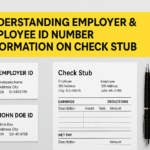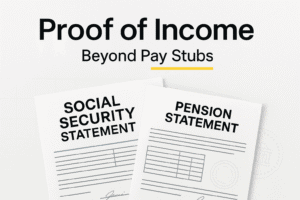Introduction: biweekly vs semimonthly pay
By FinancialDocsProvider.com Editorial Team
Published: August 2025
Last updated: August 2025
If you’re comparing biweekly vs semimonthly pay, you’re really asking two things: “How much do I make per pay period?” and “What does that mean for my monthly budget and documentation?”. This guide explains the differences, shows fast conversion formulas, and offers compliance‑first tips to package proof of income for rentals, loans, and verifications in the US, UK, and Canada.
We specialize in formatting and organizing financial paperwork—pay stubs, bank statements, income summaries—so they are clear, consistent, and audit‑friendly. We do not fabricate amounts, dates, or parties. If a lender or landlord asks for additional proof, we help you present the facts you already have in a tidy, reviewer‑friendly way.
- Need professional proof of income editing that preserves facts?
- Have messy PDFs or exports? Ask about bank statement formatting.
- Curious about fees? See our pricing.
- Questions? Contact our team.
Related Entities & Terms
- Forms: W‑2 (US employees), 1099 (US contractors), T4/T4A (Canada), P60/P45 (UK), Notice of Assessment (NOA, Canada)
- Pay documents: payslips (UK), pay stubs (US/CA), remittance advice, year‑to‑date (YTD) summaries
- Regulators: IRS, CFPB, FTC (US); FCA & GOV.UK guidance (UK); FCAC & CRA (Canada)
- Payroll: PAYE (UK), CPP/EI (Canada), FICA (US), National Insurance (UK)
- Frequency terms: weekly, biweekly (every two weeks), semimonthly (twice per month), monthly
- Budgeting: three‑paycheck months, benefit deductions, withholding, overtime
- Verification: income letter, employment verification, bank transaction reconciliation
- Security & privacy: redaction, PII masking, watermarking

Law & Compliance Basics: formatting vs. falsification
Your documents must reflect reality. Formatting and organization are allowed; fabrication is not. Across the US, UK, and Canada, submitting altered facts—amounts, dates, payees, or employers—can be treated as fraud. Our role is to help you present accurate information clearly.
United States
For US taxes and payroll, employers follow IRS rules for withholding, while lenders evaluate truthful documentation. If you need to estimate withholding, see the IRS Tax Withholding Estimator. It helps you understand why per‑paycheck amounts differ between frequencies even when annual pay is unchanged.
United Kingdom
UK employees typically receive monthly payslips under PAYE. For official guidance on payslips and deductions, refer to GOV.UK’s payroll resources, starting with PAYE for employers. Presenting payslip figures truthfully is obligatory; formatting to improve legibility is fine.
Canada
Canadian employers issue T4 slips and withhold CPP, EI, and income tax. For calculations, the CRA provides the Payroll Deductions Online Calculator (PDOC) at Canada.ca. As with other jurisdictions, altering facts is prohibited; clarity and redaction for privacy are allowed.
What Edits Are Allowed (and helpful)
Formatting can make the difference between a fast approval and a request for more documentation. Here are edits we routinely support while keeping your facts intact:
Redaction & privacy
- Mask partial account numbers, home addresses, or personal emails while preserving necessary identifiers.
- Add “Redacted for privacy” notes in margins or footers to avoid confusion.
Readability upgrades
- Correct misaligned columns from payroll exports.
- Standardize fonts, spacing, and headers; fix broken page breaks.
- Re‑label totals and YTD amounts so reviewers immediately see the key figures.
Export and packaging fixes
- Combine multiple pay stubs into one PDF with a table of contents.
- Embed accessible text layers (OCR) so lenders can search and copy figures.
- Recreate faded stamps or watermarks for legibility—without changing data.
What’s Illegal (do not do this)
Any edit that misstates facts can cross into fraud. Never:
- Alter gross pay, net pay, tax withholdings, or benefit deductions.
- Change dates, pay periods, pay frequency, or hours worked.
- Swap employer names, EINs, or addresses.
- Edit bank transactions to create deposits that did not occur.
Consequences may include denial of tenancy or credit, account closures, and potential civil or criminal exposure. When in doubt, ask the requesting party what they need and supply it truthfully. We’ll help you present it clearly—never fabricate.
Use Cases & Salary Calculators
Biweekly and semimonthly pay are easy to mix up. The math is simple once you know the definitions:
- Biweekly: paid every two weeks (typically 26 paychecks per year; some calendars produce 27).
- Semimonthly: paid twice per month on set dates (24 paychecks per year).
Quick conversion formulas
Use these to translate one frequency to another. Keep “hours per week” realistic for your industry (US standard examples assume 40 hours; UK often 37–37.5; Canada 37.5–40).
- Annual from biweekly pay: biweekly gross × 26.
- Annual from semimonthly pay: semimonthly gross × 24.
- Monthly from biweekly: biweekly gross × 26 ÷ 12 ≈ biweekly × 2.1667.
- Monthly from semimonthly: semimonthly × 2.
- Weekly from biweekly: biweekly ÷ 2.
- Weekly from semimonthly: semimonthly × 24 ÷ 52 ≈ semimonthly × 0.4615.
- Hourly from annual (US 40‑hr): annual ÷ 2,080. (Use 1,950–1,968 for 37.5–38‑hr UK/CA assumptions.)
Example 1 — US employee moving apartments
Scenario: Alex earns $25/hour, 40 hours/week, paid biweekly. A landlord wants “monthly income.”
- Annualize: $25 × 40 × 52 = $52,000.
- Monthly equivalent: $52,000 ÷ 12 = $4,333.33.
- Compare to semimonthly check size (if needed): $52,000 ÷ 24 = $2,166.67 per semimonthly period.
Packaging tip: Include last 3–4 pay stubs, YTD totals, and a one‑page summary that shows the math above. We’ll reformat stubs and create a tidy cover page without changing figures.
Example 2 — UK contractor applying for a car loan
Scenario: Priya invoices semimonthly to match client milestones, but the lender expects monthly income. Annual expected revenue: £60,000.
- Semimonthly amount for planning: £60,000 ÷ 24 = £2,500.
- Monthly equivalent for the lender: £60,000 ÷ 12 = £5,000.
- If the lender prefers weekly: £60,000 ÷ 52 ≈ £1,153.85.
Packaging tip: Provide recent payslips or invoices, bank credits that match them, and a summary table. We make sure invoice dates, references, and deposits line up visually.
Example 3 — Canada employee with variable overtime
Scenario: Jordan is paid semimonthly at CAD $3,000 base plus occasional overtime. A mortgage broker wants an annualized figure that excludes variable OT.
- Base annual: CAD $3,000 × 24 = CAD $72,000.
- Show overtime separately using YTD: e.g., CAD $4,200 YTD overtime noted as “variable.”
- Provide bank statements with matching payroll deposits.
Packaging tip: We label base vs. variable income, reconcile deposits to payslips, and add a contents page.
About “27‑paycheck” years
Biweekly schedules can occasionally produce 27 checks in a calendar year. Employers handle this differently—some adjust per‑pay amounts; others leave annual totals unchanged and simply produce one extra, smaller check. If you’re proving income, rely on annual totals or an employer letter to avoid confusion.
Why pay frequency changes your per‑check amounts
Your annual salary remains the same, but per‑paycheck tax and benefit withholding often change because calculations run each pay period. That’s why the same annual salary can yield different net amounts biweekly vs. semimonthly. For reference tools, see the IRS Withholding Estimator, GOV.UK’s PAYE pages, and the CRA’s PDOC.
W‑2 vs. 1099 vs. T4/T4A: how to present income
- W‑2 (US employees): Provide 2–4 recent pay stubs plus last year’s W‑2. If requested, include an employer letter stating role, rate, and frequency.
- 1099 (US contractors): Provide invoices, 1099‑NEC forms, and bank credits tied to the invoices. A rolling 12‑month income table helps.
- T4/T4A (Canada): Pair the most recent T4/T4A with current payslips and bank deposits; separate base pay from variable overtime or bonuses.
Mini “calculator” walkthroughs (pen‑and‑paper)
Use these step‑by‑step lists to convert income quickly without a spreadsheet.
Convert biweekly pay to monthly
- Find your latest biweekly gross on the pay stub.
- Multiply by 26 to annualize.
- Divide by 12 for monthly. (Shortcut: biweekly × 2.1667.)
Convert semimonthly pay to monthly
- Find your semimonthly gross.
- Multiply by 2. That’s your monthly gross.
Convert hourly rate to biweekly and semimonthly
- Annual: hourly × hours/week × 52.
- Biweekly: hourly × hours/week × 2.
- Semimonthly: (hourly × hours/week × 52) ÷ 24.
Convert weekly to other frequencies
- Monthly: weekly × 52 ÷ 12.
- Biweekly: weekly × 2.
- Semimonthly: weekly × 52 ÷ 24.
If you’d like, we can assemble these numbers into a clean income summary that matches your stubs and bank deposits—no changes to the facts, just professional presentation.
How We Work (intake → reconciliation → formatting → delivery)
1) Intake
Send pay stubs, payroll portal exports, or invoices and bank statements. We accept PDFs, image scans, and CSVs.
2) Reconciliation
We cross‑check amounts, dates, and YTD totals. If a bank deposit differs from a stub, we label it as partial, split, or combined—never modified.
3) Formatting
We fix spacing, headers, pagination, and add a contents page. For accessibility, we add searchable text layers and logical reading order.
4) Delivery
You receive a single, organized PDF with bookmarks. Need minor corrections? We include one round of revisions that never changes factual data.
Curious how this translates into time and cost? See our pricing and scope notes, then contact our team with your timeline.
Quick Compliance Checklist
- Match frequency labels: If your stubs are biweekly, don’t call them semimonthly. Label consistently across the packet.
- Use annualization math: Show how per‑check amounts roll up to monthly and annual figures.
- Include YTD: YTD totals on recent stubs help reviewers trust the math.
- Reconcile deposits: Tie payroll deposits to pay dates and amounts; note partials or multiple deposits for one period.
- Protect privacy: Redact account numbers and PII; leave enough to identify the account.
- Separate variable income: Overtime, commission, or bonuses should be clearly labeled as variable.
- Summarize up front: Provide a one‑page cover sheet with totals, frequency, and employer contact info.
- No fabrication—ever: We format and organize; we do not change facts.
Red Flags that Trigger Rejections
- Mismatched math: Net deposits that don’t reconcile to stubs without explanation.
- Inconsistent frequency: Calling the same pay pattern “biweekly” sometimes and “semimonthly” elsewhere.
- Missing YTD: Reviewers can’t validate earnings trajectory.
- Low‑quality scans: Cropped headers, unreadable figures, or images without searchable text.
- Copy‑paste artifacts: Font shifts or misaligned columns that suggest tampering (even if innocent).
- Undisclosed gaps: Employment breaks without a note cause extra questions.
Good formatting solves most of these without touching the underlying numbers.
Resources
Official guidance (US/UK/Canada)
- United States — IRS Tax Withholding Estimator
- United Kingdom — GOV.UK PAYE for employers
- Canada — CRA Payroll Deductions Online Calculator (PDOC)
Helpful internal links
- Fact‑preserving proof of income editing
- Clean, readable bank statement formatting
- Transparent pricing
- Questions? contact our team
FAQs
Is biweekly the same as semimonthly?
No. Biweekly means every two weeks (≈26 checks per year), while semimonthly means twice per month on fixed dates (24 checks per year). The annual salary can be the same, but per‑check amounts differ.
Which is better for budgeting?
Semimonthly produces steadier monthly cash flow because checks align with calendar months. Biweekly creates “three‑check months” a few times per year, which some people like for savings or debt pay‑downs.
Does pay frequency change my taxes?
Your annual tax liability is based on annual income, not frequency. However, per‑paycheck withholding and benefit deductions vary, changing your net per check.
How do I convert my pay to monthly?
Biweekly: multiply the check by 26 and divide by 12. Semimonthly: multiply the check by 2. If you’re hourly, first compute annual = rate × hours/week × 52.
Can you change numbers on my pay stubs?
No. We never alter factual amounts, dates, employers, or transactions. We format, organize, redact for privacy, and reconcile documents so they’re easy to review.
Need accurate, reliable financial documents fast? Contact FinancialDocsProvider.com now.








Add comment